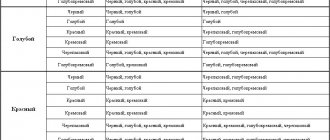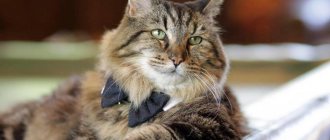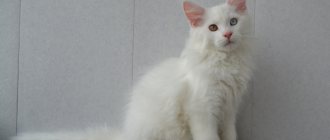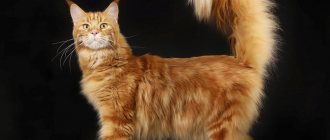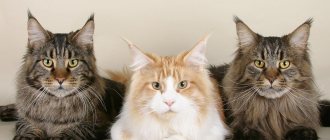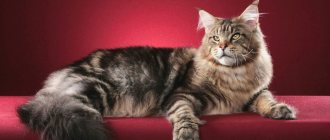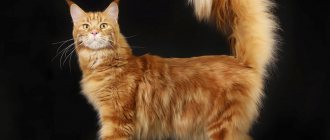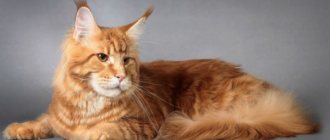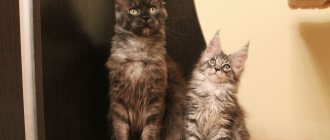From a genetic point of view, Maine Coons have two main coat colors – red and black. All other shades are different variations of the basic ones. All the variety of colors and patterns appears due to the special distribution of hair pigment, which determines the color of the animal.
Determining the hereditary color allows you to find out which cat's offspring will appear. Maine Coons are no exception here. To do this, breeders use special tables with formulas that will tell the color of future kittens. Based on them, you can decide how to cross the adults to get the desired result.
Maine Coons of different shades.
Traditional Maine Coon colors: photos and descriptions
There are several types of coat patterns called tabby.
They all have their own patterns. Tabby was inherited from the wild ancestors of modern domestic Maine Coons. Their distinctive feature is the letter “M”, which is visible in the area of the cat’s forehead and eyes with light or dark lines. There are three types of tabby:
- Tigers. The stripes on the body are parallel to each other.
- Spotted. There are spots of dark and light shades on the sides.
- Classic. Similar to the pattern of marble.
There is also a fourth type - ticked, but it is not typical for this breed. It is usually found in the Abyssinian breed and other oriental cats. It may appear in isolated coon individuals.
Often there are uniform colors in the same range; they are called solid or in the English version - solid (uniform). In this case, the tabby can be almost invisible. Often found in cats that are black in color. The darker the cat, the weaker the pattern of its coat appears. Tabby is especially pronounced in cats with fur of red (red) shades. Solids can be in the following palette:
- black;
- cream;
- red;
- smoky;
- blue.
Smoky gray and blue are of particular interest to Maine Coon breeders, as they are very rare for representatives of this breed. The gallery below shows photos of popular colors.
Maine Coon color calculator
To understand what color will result from crossing animals, breeders use a calculator table. With its help, you can predict with a very high probability what color the offspring of a thoroughbred couple will inherit.
How the coat colors of Maine Coon offspring interbreed.
This is, of course, not a guaranteed result, as it is impossible to calculate the exact genetic combination a kitten will inherit. From time to time, extremely interesting representatives of coons are born, having, for example, tortoiseshell tones, which is very rare for this breed. It has been noticed that most of these individuals are female.
Gray Maine Coon
Gray or blue colors are considered rare for this breed.
An even color of blue shades is a rare occurrence. A smoky shade is usually found. These cats look special; their color gives them their aristocratic charm. If a cat is exactly like this, it means that the gene responsible for the presence of a pattern on the body has been completely suppressed.
Blue tones are specially developed through selective breeding. This takes a lot of time and effort from breeders. The letter “A” is placed in the passport of such a kuna. If the cat has two-color fur, the code “03” is added to the letter designation.
How to take care of your Maine Coon's gray coat?
There is no doubt that the fluffy and thick fur of Maine Coons is one of their decorations. To ensure that your animal’s hair does not lose its shine, you should remember the following:
- For health in general and an attractive coat in particular, Maine Coons need proper nutrition. Dry or canned ready-made food labeled “for Maine Coons” (or “for large cats”) of super-premium quality (or holistic) is suitable as a diet. As an alternative to store-bought food, natural food is often chosen, which includes lean meat, cereals, vegetables (greens and fruits, if the cat likes them), and sour milk products. If the animal eats the food that the owner prepares for it, you will have to think about fortification. A lack of vitamins E and B always contributes to the deterioration of the coat;
- Almost any disease makes a luxurious fur coat faded and ugly. Stress, invasive diseases, poisoning, skin diseases are just some of the reasons why the fur looks untidy. To understand that an animal is unhealthy, sometimes it is enough to look at its fur;
- Maine Coons are naturally clean cats, so you shouldn’t bathe them often. As a rule, bath procedures are carried out once every 3-6 months using a special shampoo for long-haired cats, after which the pets are dried with towels and a hairdryer. Show cats are bathed more often, before each appearance. In this case, not only cleansing shampoo is used, but also coloring, degreasing and texturizing grooming products;
- Domestic gray Maine Coons are brushed two to three times a week, and daily during shedding. For the fur on the body, brushes with long teeth are used, for the face and limbs - with short ones. Sometimes they do it differently: first they comb the cat with a brush with sparse teeth, and then with frequent ones. It’s hardly worth neglecting combing, because thick fur will quickly form tangles that will simply have to be cut out, depriving the animal of hair growth;
- During shedding, gray Maine Coons lose hair no less than other long-haired cats. Typically, the fur begins to shed twice a year, usually in early spring and late summer or fall. If the air in the room is too dry, shedding may be prolonged. To prevent the animal from swallowing hair during active hair loss, it makes sense not to neglect combing. And if necessary, you can give the cat a special product - a paste or gel for removing hairballs;
- Sometimes handsome Maine Coons are taken to a grooming salon for a haircut (usually the hair on the body is shortened). On the one hand, after a haircut, it is easier for an animal to survive the heat (especially if there are no cooling devices in the apartment). And the owner has less worries in the form of lengthy combing. However, almost all owners who have carried out a similar procedure at least once note that the new coat that grows is of poorer quality: thinner and more prone to tangling. It turns out that it is better to remove dead hairs with a regular brush, without depriving the Maine Coon of his thick and beautiful coat.
The rarest and most expensive Maine Coon colors
Each breed has rare colors that are not often seen. Maine Coons are no exception. This breed has its own rare shades:
- Brown with spots. These kittens have a color similar to autumn foliage.
- Creamy blue. Looks like tortoiseshell with rare pastel shades.
- Chintz. This is a unique coloring for coons. The base is red, diluted with black tones with white splashes.
- Watered down chintz. There are cream-colored spots on a white background, and blue colors have a solid coloring.
- Spotted with white spots.
Such colors are not typical for coons and are rare.
Smoky
Such cats can be black or blue. The intensity of the haze determines the subspecies:
| Name | Description |
| Chinchilla | Only the tip of the hair is pigmented |
| Shaded | color has a quarter of the hair |
| Smoke | Only the root of the hair is colored white, the main part has black or blue pigments |
| True smoke | Half of the hair has pigmentation |
| Silver | the hair is white at the root, the rest is light silver |
| Cream | at birth, the coat is uniform in color, but gradually becomes unevenly pigmented |
| Classic wild | brindle, marbled black, spotted |
Smoky cats are characterized by white roots. Gray is usually found in monochromatic animals.
Chocolate
The wool is colored brown, warm, rich. The presence of inclusions of other shades or patterns is not allowed. The hairs have an even distribution of pigment. Unlike red tones, it is darker and deeper. Quite rare in breeding. The paw pads and nose also have brown tones.
Classic wild
This color suggests the presence of a pattern on the animal's fur. They can be of different types:
- brindle;
- marble black;
- spotted.
These are the main colors of coons that were common among their wild ancestors.
Peach
These cats have similar features to their cream counterparts. These can be yellow, orange shades characteristic of tabby coons.
Black
Black monochromatic coloring is extremely rare for this breed.
Each black coon has a different color depth and saturation, so it is impossible to find two identical black cats. Usually, this color hides the pattern on the coat. In small kittens it can be difficult to see, but as they grow older it is completely hidden. The cat becomes completely monochrome. An animal with black fur looks regal, luxurious, reminiscent of a majestic panther in appearance.
Black and white
Cats with this coloration have different proportions of these colors:
- Black with white spots. There are several small spots of white on the fur.
- White medallion. A white spot is located on the chest of the animal, reminiscent of decoration.
- White gloves. The cat has black and only white paws of the animal.
- White tuxedo. There is a white shirtfront on the neck, and the paws are also white.
- Bicolor. Black and white in a 1/1 ratio.
- Harlequin. The color is predominantly white with a few black spots.
- Wang. The head and tail are painted black. The rest of the body is white.
What is the danger of white color
White Coons have a predisposition to complete deafness.
It is found in this color much more often than in animals with a different shade of fur. However, there is no need to be upset by this fact. Deaf individuals feel great.
They live well in the house, and are oriented to the area no worse than healthy ones. Their hearing loss is compensated by vision and a keen sense of smell. People who do not know about cat deafness will not guess about it.
Cream
This shade is obtained by lightening the red. The animals are colored in shades similar to raw ginger. When crossing, individuals with genetically weakly expressed pigment in the pedigree are preferred. However, theoretically, even Black Solid Maine Coons can produce cream-colored offspring.
Exterior
The state of Maine, located in the northeastern part of the United States, is considered the homeland of cats of this breed. Animals are difficult to care for and maintain. But their unique appearance makes them popular among Russians.
Description of the appearance of Maine Coons:
- The head is wide and large, the cheekbones stand out well.
- The ears are large, with pointed ends, set high.
- The muzzle is short and square in shape.
- The eyes are oval and large, slightly slanted.
- The chest is wide.
- The body is massive, rectangular, harmoniously built.
- The tail is bushy and long.
- The paws are shaggy and strong.
- The coat is thick and long, forming a collar around the head.
- The height at the withers of an adult animal reaches 45 cm.
- Common colors are merle, red, gray, black, white, blue, tortoiseshell.
- Average weight is 4.5-7 kg for females and 13 kg for males.
Maine Coons are docile, calm, and easy to train. They treat outsiders with distrust. On average they live about 20 years .
Advantages of the breed:
- Devotion.
- Longevity.
- High intelligence.
- Good nature.
- Unobtrusiveness.
- Playfulness.
- Non-aggression.
Flaws:
- Frequent shedding.
- Need for constant care.
- Great appetite.
- They do not tolerate hot weather well.
Tortoiseshell
The tortoiseshell Maine Coon comes in two types – torby and torty.
The first type is a combination of red and black shades of wool, expressed in a dark brown color. The torti has a greater addition of red with dark cream. Of particular interest is the fact that tortoiseshell coloring is most often found in cats.
The probability of a male being born with this coloring is approximately 1 in 1000.
On such cats, markings of different sizes and shapes are more clearly visible. Based on the severity of these spots, several colors can be distinguished:
- calico;
- flap;
- chintz.
These cats are characterized by the presence of red shades of fur. The classic color, consisting of three colors, is obtained by mixing black and red. This makes the coat more variegated. There are also several tortoiseshell shades.
Scaly tortoiseshell
Reminiscent of fish scales, the order of spots on the body is checkerboard. These spots alternate in black and red tones and are unevenly distributed. Any one of the colors may predominate.
Calico and solid tortoiseshell (patchwork)
The spots of black and red color resemble flaps. They have defined boundaries and can overlap each other. If the wool has white patches, this color is called “tortoiseshell white” or calico. Red and black spots are solid in color and clearly visible on the animal’s body.
Patterned tortoiseshell
Multi-colored spots have a pronounced pattern. These may be spots or stripes, but marbled colors are also common. There may be small white spots. In this case, it is fashionable to say that the color is spotted tabby or tabby with white spots.
Food for cats with light fur
For light shades of wool, it is important to maintain not only a balanced diet, but also the composition. After all, a lot of products can destroy the snow-white or ashen colors of a fur coat.
If your pet eats commercial food, then you should pay attention to its composition; it should not contain:
- Beets, carrots, seaweed.
- Liver. Chicken and beef in economy-class food will also color the animal's fur.
- Copper. This element is often found in feed, and its increased dose can cause yellowness.
- All “goodies” and vitamins for cats should be studied in detail for dyes and additives.
Marble colors
Can be cold or warm tones. The first has more gray tones, while the warm one is dominated by brown shades. These stains sparkle in the sun in a special way, which many people like. Such stains can be drawn in different ways - stripes, spots, contours. Such spots can be well defined, then they are more reminiscent of a tortoiseshell color. Marble coloring has more diffuse, blurred borders of spots.
Tabby
This type of coloring is present in all representatives of the Maine Coon breed, but may not be expressed in a bright form. This color is a genetic predisposition. A cat's hair has its own zoning or striping. The wild ancestors were tabbies, which was inherited by modern representatives. There are various options for this design.
Classic, spotted and brindle tabby
Characterized by wide stripes of a spiral shape. They are usually located on the sides of the animal, and can resemble marble stains. Spotted tabbies have intermittent stripes or spots of color throughout the animal's body. The brindle tabby is similar to the brindle coloring - vertical stripes along the entire length of the body.
Ticked Tabby
These cats have no stripes or spots at all. The fur has a peculiar pattern on the face, paws, and chest. Ticking is the distribution of pigment along the hair. The tip has a rich shade, gradually losing brightness towards its root.
Features and color variations
Objectively, white color in Maine Coons (and all other cats) is not a color. It is expressed by the absence of the coloring pigment eumelanin (black) or pheomelanin (red) and therefore purely symbolically performs the function of characterizing color.
The genetic process begins at the stage of early embryonic development and proceeds as follows:
- Pigment cells take on an elongated ellipsoidal shape and migrate to the area of the developing dermal layer of the skin.
- The centers of pigmentation in cats are located on the head, neck, along the line of the spine and at the base of the tail.
- The cells penetrate the follicles (hair follicles) before they form. Only then do they become melanocytes, which produce coloring pigment.
But all of the above works only in one case - if there is no dominant W gene in the cat’s chromosome map. It suppresses the entire algorithm and then the Maine Coon’s fur remains white, uncolored. And white cats should not be confused with albinos - the nature of the colors is different, as are the genes responsible for such anomalies.
It happens that a snow-white Maine Coon cat has 1-2 colored spots appear somewhere on its fur coat - evidence that we are talking about white spotting. It can manifest itself in extreme forms, when large areas of white color overlap areas of black and red pigments.
Read all about Maine Coon colors in this article.
Combinations of S and W alleles are responsible for this.
- not white – ww;
- bicolor –Ss.
The entire design of color combinations in cats with white coat color rests on these two genes.
- Buttons scattered randomly all over the body.
- White markings in the form of medallions (small spot on the chest), gloves (end of the paws) or tuxedo (chest, legs, head).
- Colored spots on the back and head (“magpie” color).
The main classification of white Maine Coons takes into account the percentage of white and any other color.
- Bicolor – the main color takes up up to 50%.
- Particolor - the proportion of white reaches 90%.
- Harlequin - over 90%.
- Van color of white Maine Coon cats - markings of a different color are present only on the tail and head in the area of the ears.
In bicolor, as a rule, there is an additional ornament on the fur coat. The Maine Coon with a brindle coat and white spots is much more common than its pure white coated counterpart. In the ash coloring, the brindle has a marbled appearance, which gives its name to the separate group.
There is another gradation in the distribution of white color in Maine Coons. It can be expressed in formulas of genes and alleles, but most often practical observations are used.
- The white gene suppresses all others.
- A white Maine Coon kitten must have an equally white parent. Color cannot appear only in the grandfather and grandson. The father is obliged to take his place in this hereditary chain.
- The same rule exists for the color of the undercoat - it is inherited as a direct trait.
- The calico (tortoiseshell and white) combination is dominant over the blue and cream tortoiseshell.
- Variegated (piebald) colors of white are always ahead of solid colors. The same rule applies in the case of white spotting, which prevents the formation of a pure color.
Important! Maine Coons with a perfect white coat do not have brindle stripes. The dominant W gene suppresses the action of all other participants in the genetic process and discolors the fur over the entire surface of the cat’s body.
Random color combination
Sometimes there are situations when the maine has a color that does not fit any of the color types. For this purpose, its own classification was created. These colors can be called:
- Brown tabby with spots. Such an animal has spots of red and brown.
- Blue spotted tabby. The cat in this case has cream and blue stripes on its body.
- Creamy blue. The spots are scattered in a chaotic manner throughout the body. This color is sometimes called a blue turtle.
- Creamy blue, white.
- Spotted tabby with white spots. The color is similar to the previous one, but there are inclusions of white spots.
Such combinations are also rare.
White Maine Coon eye color
There are some restrictions on eye color in the Maine Coon breed standard, but exceptions are allowed for animals with a white coat.
- Maine Coons are often found with blue eyes.
- A white cat can be born with different eyes (heterochromia).
Bicolor, tortoiseshell, or spotted cats often have eyes that are green, honey, or copper in color.
There is an opinion that a separate gene is responsible for the formation of blue or different eye colors in white Maine Coons. Such a judgment has nothing to do with scientific discoveries.
Eye color is not affected by any of the genes known to scientists. The shade of the iris is formed depending on the color of the coat and the depth of penetration of pigment cells.
This is interesting! Sometimes there are Maine Coons in which each eye is painted in two colors - closer to the bridge of the nose it is blue or light blue, and the outer edge is copper or orange.
Unrecognized
Chocolate, gold, and lilac colors are not allowed at specialized exhibitions. Coons with Siamese coat color are also not recognized. There are patterns that are considered unrecognized for the Coons. These can be called:
- faun;
- cinnamon;
- point;
- sorrel;
- acromelanic color.
The coat color of Maine Coons is distinguished by a huge variety of colors and their combinations. The eyes of purebred animals must match the color of their fur. They can be blue (only pure white wool), green, yellow. White individuals may have different colored eyes (blue and green).
Tortoiseshell colors
The tortoiseshell color of the Maine Coon is associated with the history and origin of the breed. Since ancient times, these giant cats have had to adapt to survive in North America, where winters are often frosty and long. It was the tortoiseshell colors of the “fur coat” that served as a real salvation for cats, because with its help they could hide unnoticed in snowy thickets. The tortoiseshell color on the coat of Maine Coons remains quite popular to this day.
EMS color code
The International Association of Felinologists has developed a table that includes color options recognized by professional breeders. We need such a systematic collection for the convenience of making entries in the pedigree of the animal, bringing information about the breed to a single standard.
Unified table of coat colors according to EMS coding.
Thus, all colors not included in the standard coding are considered coat color defects. Individuals with unrecognized colors are not allowed at exhibitions and are not used in breeding.
However, they are suitable for home keeping in the same way as those with coat colors included in the table. Representatives of this breed have many genetically determined color options. Each Maine Coon is beautiful in its own way, no matter what color nature gave it.
Maine Coon coat care
Many may mistakenly believe that white wool is very expensive and requires some additional physical and financial costs. However, in the case of a Maine Coon, there is nothing to worry about.
© shutterstock
The wool cleans itself, and dirt does not eat into the hair. It is enough to use simple care, like for any cat.
What do we have to do:
- Brush weekly.
- Bath as needed.
- Do not feed foods that may impart an undesirable tint. On this point, it is best to consult additionally with the breeder and veterinarian.
In addition, I would like to note that Maine Coons’ hair does not get tangled or tangled. Therefore, you don't have to worry that combing will be some kind of complicated process.
